Do not be afraid, keep the challenging spirit alive!
This interview was published in the Autumn 2022 issue of Litterae Populi.

After working for IBM Japan Ltd. for over thirty years, Satoko Shisai moved to Chugai Pharmaceutical Co., Ltd. She leads the DX (Digital Transformation) strategy to realize the “CHUGAI DIGITAL VISION 2030” (Chugai Pharmaceutical’s vision for 2030: “Chugai innovates its own business through digital technology to make Chugai a top innovator to provide society-changing healthcare solutions”).
President Kiyohiro Houkin, who has been promoting reforms with the intention of becom- ing an unparalleled university, interviewed Satoko Shisai, a graduate of the University, about her life, initiatives at Chugai Pharmaceutical, and her expectations of the University.
Satoko Shisai (Guest)
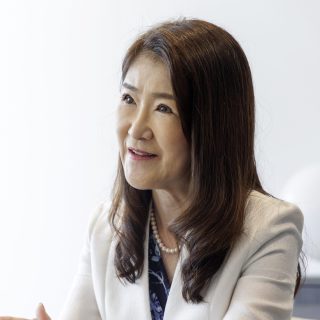
Born in Hokkaido in 1963. Graduated from Hokkaido University School of Law and joined IBM Japan, Ltd. in 1986. Served as sales manager of the Second Public Service Department and then moved to IBM Corp. in the US in 2008. After returning to Japan, served as an executive officer at IBM Japan. Transferred to the position of executive officer at Chugai Pharmaceutical in 2019. Assumed present position in April 2022.
Kiyohiro Houkin (Interviewer)
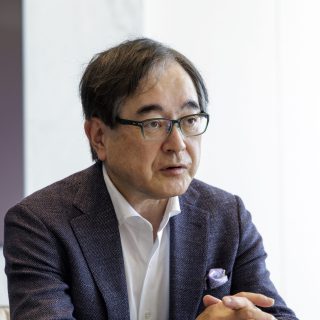
Born in Hokkaido in 1954. Graduated from Hokkaido University School of Medicine. Doctor (medicine) (Hokkaido University). Worked for Hokkaido University Hospital and other facilities since 1979. After working as a visiting researcher at the University of California, Davis, became an assistant professor at the Hokkaido University Graduate School of Medicine in 2000, professor of Sapporo Medical University School of Medicine in 2001 and professor of the Hokkaido University Graduate School of Medicine in 2010. After becoming the director of Hokkaido University Hospital/ vice executive of Hokkaido University in 2013 and the director of Hokkaido University Hospital/vice president of Hokkaido University in 2017, assumed the present position in October 2020.
Sharpening my English skills and fostering internationalism during my student days
Houkin: Firstly, please tell us about your background and why you studied at Hokkaido University.
Shisai: I was born in Nemuro City but moved around Hokkaido due to my parents’ work. One of my Japanese teachers at Sapporo Minami High School suggested that women study law to have a solid career. This teacher’s words triggered my decision to attend the School of Law at Hokkaido University.
Houkin: What was your student life like at Hokkaido University? I was in the rowing club and felt that the experience of also being dedicated to non- academic, extra-curricular activities during my student life were significant in nurturing a rich sense of humanity and expanding my relationships.
Shisai: Influenced by my father, who worked in international exchange, I thought it was essential to learn English and I therefore joined the ESS (English Speaking Society) club. Preparation for tournaments, contests, and debates was hard work, but the close relationship between seniors and juniors and the experience of learning from my seniors are still alive today. It may seem surprising since it is an English-speaking circle, but we always sang “Miyako zo Yayoi” after every event.
I still meet some of my seniors from ESS. For example, Mineko Hino, a professional conference interpreter, has been a shining star in debate competitions since those days and was a fantastic senior. We have been working together recently, and I feel a connection with her.
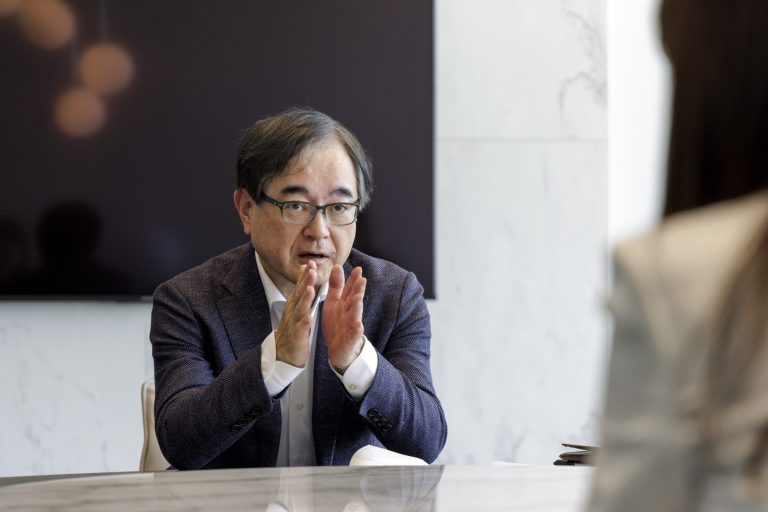
Houkin: The experience of going abroad as a student is also valuable. I went to Indonesia to study cholera.
Shisai: When I was a third-year undergraduate student, I participated in a speech contest sponsored by the Lions Club and was selected as a representative of Hokkaido. Therefore, I went to Edmonton (Alberta, Canada) during the summer vacation. It was my first experience abroad, and I enjoyed it so much that I could hardly sleep. I was also totally overwhelmed by the magnificent nature of Jasper National Park.
Facing and overcoming various challenges and on the way forward
Houkin: After graduation, you joined IBM, didn’t you?
Shisai: I entered the workforce at a time when the Equal Employment Opportunity Law was enacted. However, although there were no ostensible differences between men and women, there were still vestiges of a male-centered perspective. I also felt there were low expectations of women in the industries that law students work, such as trading companies, banks, and insurance companies, so I focused my interviews on companies where women could work in the same way as men, regardless of the industry. At the time, IBM was the largest computer company in the world, and I was under the impression that men and women would be treated equally. After joining the company, I found that to be the case, so I believe that I made the right choice.
Today, many career women of my generation are working hard as the first women in various industries who have held a managerial track position. However, those days were still more challenging than today.
Houkin: What efforts did you make to create a comfortable working environment for women in your company?
Shisai: Compared to other companies in Japan, it was overwhelmingly easier to work at my company, and I am very thankful. Women were promoted based on their abilities, and there were no differences between men and women. However, the sales department had only a few female workers, including myself, and women’s roles in the workplace did not expand, so my other role was to successfully orient junior women to sales positions.
Among IBM companies operating globally, women at IBM Japan were not yet active in the company. Therefore, a group called the “Japan Women’s Council” was established within the company, under the president’s direct control. About thirty women from various divisions gathered to propose ways of improving the working environment. At one time I served as the leader.
It was important not only to make proposals but also to build a network among women who were aware of the issues. As a result, Yukako Uchinaga, the leader during the first term—who is still active as a businesswoman—launched the NPO Japan Women’s Innovative Network (J-Win), with the involvement of other companies, while she was working for IBM, which led to the expansion of exchanges.
Houkin: You took a one-year leave of absence after you gave birth. Didn’t you feel like you were falling behind compared to men who continued to work?
Shisai: It did not bother me much. As a result, I was reassigned to the public sector after I returned to work. At the time, IBM’s share of public-sector demand was tiny. In this context, I decided to reset my career and start over again. I had a lot of freedom in my work, and the more I found and handled work independently, the busier I became.
In some cases, employees who return to work post-maternity leave were only assigned supportive tasks out of their supervisor’s consideration, but that then becomes their regular work. As a result, they cannot return to their original duties. When there was such a female employee, I would sometimes push her to return to her primary duties.
Houkin: I think many people find it quite challenging to fill in the one-year gap, but the fact that you could do it smoothly is terrific. You are remarkably adaptable.
Next, please tell us about your experience working in the US.
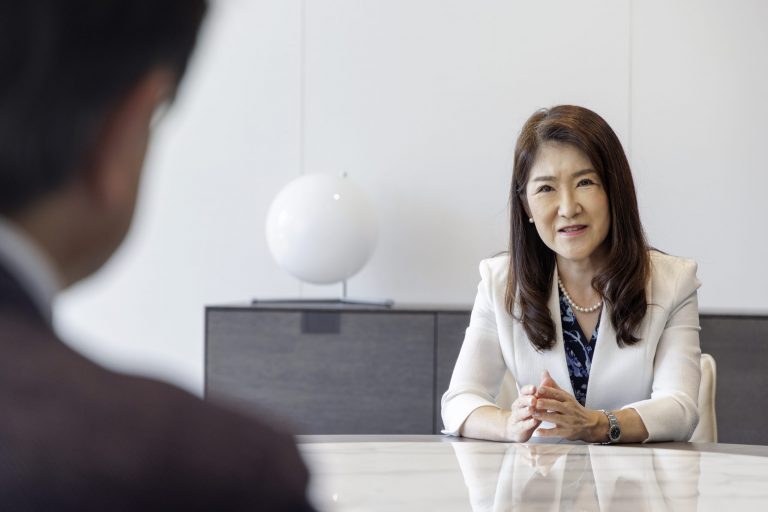
Shisai: I felt like the career and confidence I had built up earlier had gone back to zero. Since I was assigned as a director, people would come to me at first when I launched a project. But employees of foreign companies would leave me if they found that participation in the project would not benefit them. I realized that kind of difficulty at the age of forty- five.
At first, I had a hard time communicating in English. No matter how hard it was, I had to consciously listen to what they said until I understood; otherwise, conversations would increasingly flow over me, and I would be left behind (laughs). All American employees are highly ambitious about their careers, so they will not wait for others or care about them. So, I had to be assertive and jump in. It was so awful that I developed a stomach ulcer.
Nevertheless, when I returned to Japan, the project I had created was finally taking shape, with the members consulting me on the details. As a result, I learned much about the importance of continuous communication.
Benefiting alumni connections and being active in the new world
Houkin: In 2019, you moved to your current position as Executive Officer at Chugai Pharmaceutical.
Shisai: I was thinking about changing my career after the age of fifty-five and was looking for a new industry, targeting Japanese companies that would be a challenge for me. I then received an offer from Mr. Tatsuro Kosaka, the president of Chugai Pharmaceutical at the time, to serve as an officer to promote IT and DX (Digital Transformation) throughout the company. I had originally got to know Mr. Kosaka through the Tokyo Alumni association.
Houkin: The connections we have as Hokkaido University students are significant. A common background, such as studying at the same place, is meaningful.
What kind of work are you currently doing?
Shisai: I implement IT and DX strategies from a customer’s perspective. I create a vision of why we digitize and what we aim at, and then build the system to put these theories into practice. It is exciting to design something from scratch and to create a mechanism that employees agree with and launch a project to materialize it.
Houkin: Reforms to digitize organizational activities are challenging both in the public and private sectors. Our university also needs to improve research, educational, and social contribution capabilities by digitizing education, research, and paperwork tasks. On the other hand, when starting such reforms there is a strong tendency to meet with resistance and calls to maintain the status quo.
Shisai: Initially, Chugai was also behind our industry peers. On the other hand, with a thousand researchers involved in in-house drug discovery development, there was value in utilizing digital and AI (artificial intelligence). Our employees have finally successfully used those technologies in loading images, searching articles, employing machine learning of antibody sequences, etc.
DX of the research dimension is the most important, but there are other areas in value chain DX, including product development, manufacturing, factories, and customer interface. For example, in recent years, due to the COVID-19 pandemic, we have not been able to meet with physicians, who are our customers, but efficient communication is now possible through digital technology.
Any digitalization reform is always accompanied by early adaptors (those who can adapt from the initial stage) and the late-comer majority (most employees, who take their time). When the early adaptors start to do well by launching projects, obtaining budgets, and creating successful cases, the majority will follow suit, because they are forced to do something about it. Of course, some people are still reluctant to go digital, but it is better not to try to convince those who cannot apply it or to pay undue attention to them.
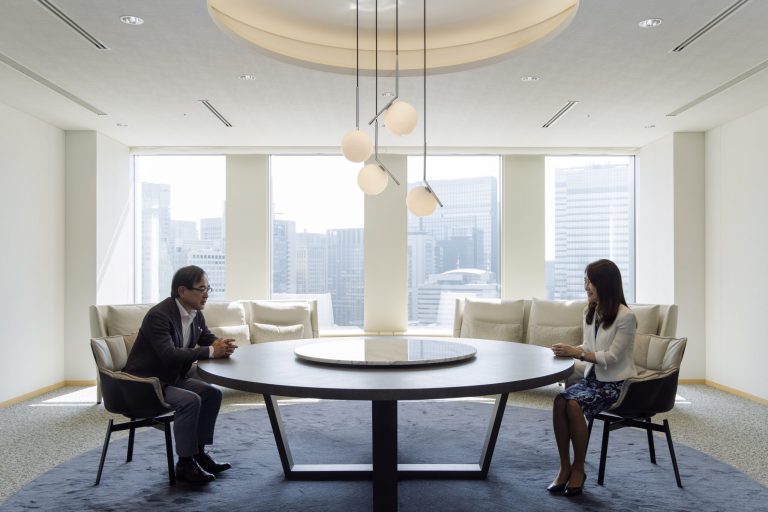
Houkin: As you experienced, the alumni association is an opportunity to reconnect with those who have been active and established their position in society. I expect that you serve as a role model for active female graduates.
Shisai: In my case, I had the great experience of being a fellow of Nitobe College through the alumni association. I am thankful for that learning experience.
Houkin: Finally, do you have any message for students and Hokkaido University?
Shisai: Companies are running out of human resources in digital and other new fields, so what I mostly expect from universities is human resource development. I would like to see the University produce more and more promising students. Students at Nitobe college are active, which leads to the attractiveness of Hokkaido University in the eyes of companies. Compared to when I was a student, there are now numerous opportunities to learn interdisciplinary knowledge and English. Teachers are enthusiastic about education, so I want students to challenge themselves to try new things.
Houkin: Thank you very much for your time today.
This interview was published in the Autumn 2022 issue of Litterae Populi.
